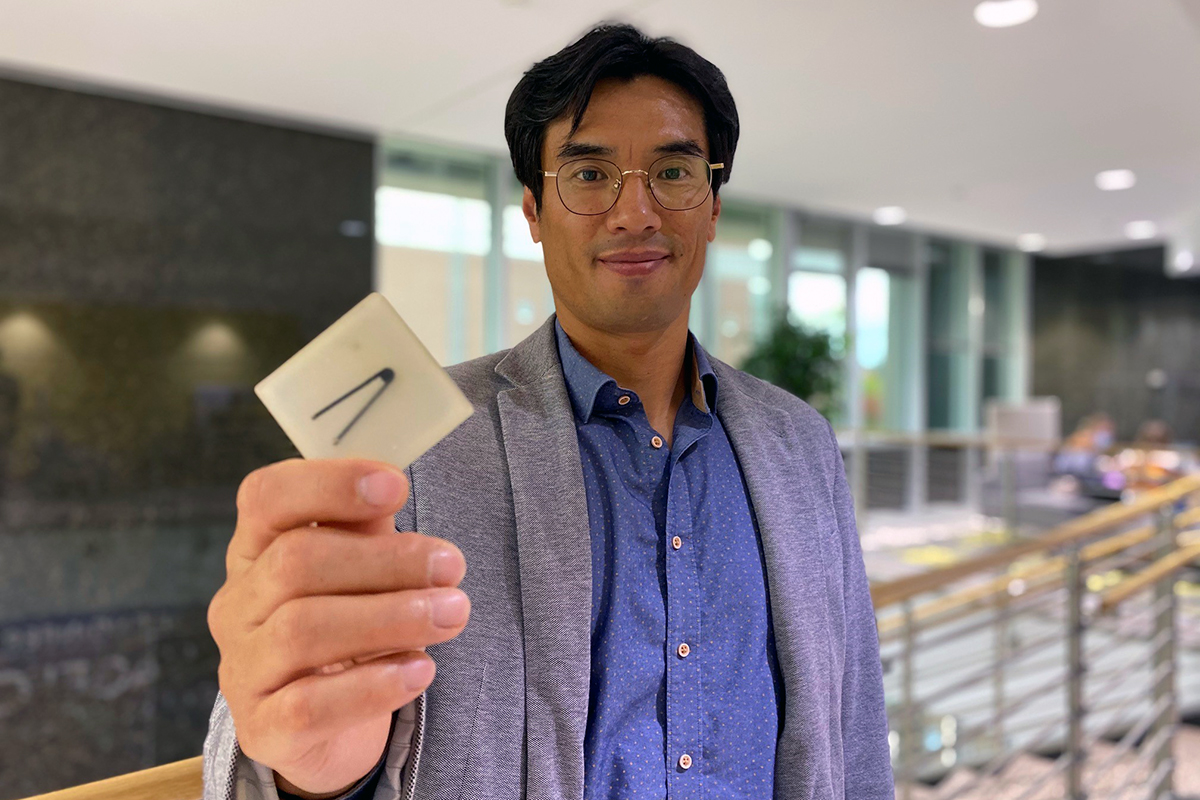Engineering professor develops 3D printed smart sensor to improve a runner’s performance

UA engineering professor Dr. Jae-Won Choi displaying a prototype of his 3D printed smart sensor.
Check out our latest engineering researcher Q&A featuring Dr. Jae-Won Choi, associate professor in the Department of Mechanical Engineering. Dr. Choi recently received a $1 million grant from the National Science Foundation to develop a soft pressure sensor for a shoe insert that can improve a runner’s performance.
What interested you in this work?
I have been always interested in new processes, materials, and applications of 3D printing. Once I joined The University of Akron in 2011, I became curious in the fabrication of smart objects using 3D printers. At that time, 3D printed parts were mainly used for structural functions, not smart functions. Smart structures are materials that respond to outside stimulation by integrating mechanical and electrical components such as a frame, sensor and actuator. Think about our tissues, which sense and move. The sensor is the outmost layer of our skin, the actuator is the muscle, and frame is the bone.
I was fascinated by the idea of using a smart, 3D printed sensor to improve a runner’s performance. My research team was able to successfully engineer this product using a research-purpose 3D printer. If this product were to go to market, it would most likely be screen printed due to cost of production (3D printing is expensive for mass production).
Tell me how you developed the sensor. What are the sensors made out of?
The sensor consists of multiple layers for protective covers, electrical wires, and pressure-sensitive membranes. All these layers were made by a stretchable and printable polymer or polymer composite. The electrical wires are based on carbon nanotubes and pressure-sensitive membranes include ions.
What are the real-world implications of this work?
We are developing a low-cost, conformable and customizable pressure sensing shoe insert that measures a runner’s gait stride-by-stride in the real world. The shoe insert can provide runner and their coaches real-time data such as pace, gait, and foot strike, in the real world. This work can be also extended to the medical field to help diabetic patients by measuring offload foot pressure and smart tires to real time detect road conditions in future autonomous cars.
Who will benefit from this work?
Wearable electronics developers and manufacturers
Where has the sensor been tested?
So far, the device has been tested in my lab at The University of Akron. Though preliminary results indicate that the sensor is highly accurate, a larger-scale test with more real-world users must be performed to definitively determine its accuracy and to expand user types.
What is your ultimate goal?
My goal is to make my technology available to industry in order to advance current manufacturing capabilities of complete smart structures that have artificial tissue made from frames, sensors, and actuators. These artificial tissues can be used for robotics to mirror the functions of a human body. In addition, our technology can be used to develop prosthetics for amputees. There is endless potential.
Tell us about your research team.
In 2015, the UA startup eSens was established to research 3D printing technology for smart structures, leading to 3 patents on 3D printed tactile sensors. This initial research contributed to this work. The research team was formed by the current CEO Dr. Tom Swiger, past graduate students Dr. Morteza Vatani and Dr. Omar Faruk Emon, former eSens member Mr. Ben Kent with UA’s Dr. Gopal Nardkrani for his continuous supports on technology transfer, and Ms. Elyse Ball for her continuous management on the eSens meetings and proposal work.
RELATED CONTENT:
- Learn more about Dr. Choi and his research.
- Read the article we published last year on Dr. Omar Faruk Emon’s smart sensor.
Media contact: Cristine Boyd, 330-972-6476 or cboyd@uakron.edu.
